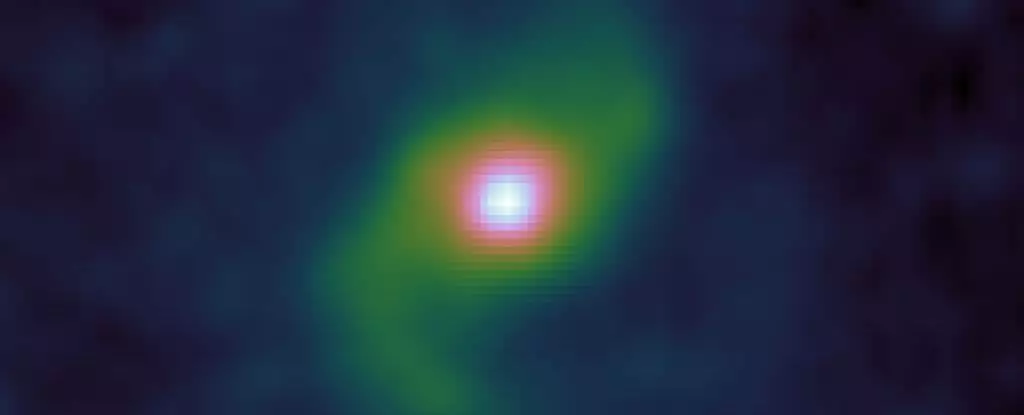Galaxies are the magnificent lumbering giants of the universe, and the study of their development provides us with crucial insights into the cosmos’ formative years. Recently, the discovery of galaxy J0107a has intensified discussions around early galactic formation, revealing complex structures earlier than previously thought possible. This spiral galaxy, astonishingly well-formed just 2.6 billion years post-Big Bang, challenges previously held assumptions about how galaxies evolve.
The Astonishing Discovery of J0107a
Astronomers, led by Shuo Huang of the National Astronomical Observatory of Japan, have turned their gaze towards J0107a, a sprawling spiral galaxy boasting 450 billion solar masses. What’s riveting about this finding is its intrinsic bar structure—a hallmark usually associated with more developed galaxies. The existence of this stable galactic bar so early in the universe’s history poses a significant conundrum: How could such an intricate structure develop in the relatively short timespan after the Big Bang?
The identification of J0107a leads us to reevaluate the timeline of galactic formation. Traditionally, theorists proposed a slower progression, where black holes draw in gas over millions of years, gradually triggering star formation. However, J0107a appears to upend these paradigms, revealing that galaxies might undergo rapid formation through channels of gas flowing directly from the cosmic web, seamlessly creating mature structures in the very early universe.
The Implications of Galactic Bars
Galactic bars have long been considered essential facilitators in the redistribution of gas within galaxies, steering this material towards their centers, thus enabling star formation. Huang’s research team discovered that J0107a’s bar channels gas at an astonishing rate of 600 solar masses annually—a rate estimated to be 10 to 100 times faster than comparable galaxies in our current local universe. This swift motion raises important questions about the evolution and lifecycle of galaxies. If bars help fuel the vibrant star formation we observe, could they hold the key to understanding star formation mechanisms in early galaxies?
Equally intriguing is the inference that J0107a may not have experienced significant gravitational interactions with other galaxies since its formation. The relatively undisturbed nature of its bar structure suggests that this galaxy has maintained its integrity through the many tumultuous epochs of cosmic history. The implications here are profound: they imply an accelerated, self-contained growth mechanism could have been at work much earlier than previously modeled.
The Need for a Paradigm Shift
J0107a stands as a beacon, illuminating the shadows of our understanding about cosmic evolution. The similarities between this early galaxy and present-day galaxies may signal the need for a dramatic shift in how we approach galactic evolution models. With traditional models struggling to account for such well-structured galaxies appearing so early, astronomers must now reassess the foundational narratives of galactic development.
Could it be that the density of gas in young galaxies like J0107a warrants different star formation processes, diverging even from what we observe today? Huang points out that the gas in J0107a is denser than what is typical in local galaxies, challenging the accepted notion that star formation invariably occurs under similar conditions. The richness of these observations suggests that the universe may have been a more dynamic and varied landscape than we previously envisioned.
Future Research Directions
With J0107a’s potential to reshape our understanding of the universe, future research must hone in on this galaxy to decode its secrets further. Observations through cutting-edge telescopes like the James Webb Space Telescope (JWST) and the Atacama Large Millimeter/submillimeter Array (ALMA) will be crucial. By studying gas distribution, star formation rates, and the internal dynamics of J0107a, astronomers can derive answers to unresolved questions about early galaxies.
What we learn from J0107a will likely catalyze new theories and models in cosmology. It may usher an era where we recognize that early galaxies were not merely primordial blobs of gas, but instead highly organized structures capable of rapid development. This shift in perspective could have vast implications, not just for galactic astronomy, but for our understanding of the history and evolution of the universe itself.
J0107a’s revelation is a reminder that our universe is filled with mysteries yet to unravel, encouraging a renewed appreciation for the complexity and beauty of cosmic formation processes. With every discovery, we inch closer toward charting the intricate tapestry of cosmic evolution that shapes our existence.

